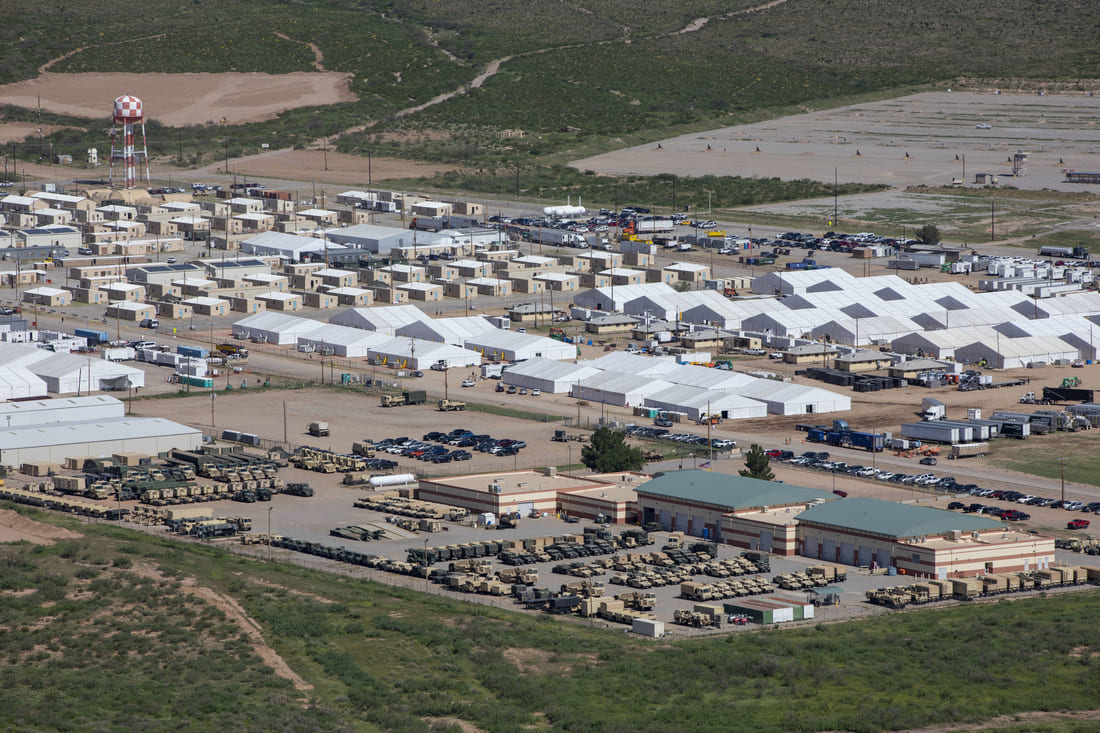The U.S. Army awarded a contract worth up to $1.2 billion to Acquisition Logistics LLC to build and operate a large immigration detention complex on Fort Bliss near El Paso.
The company is a small Virginia-based business with no publicly documented experience operating correctional facilities and no prior federal awards exceeding $16 million. Its listed headquarters is a private residence in suburban Virginia owned by company president Ken A. Wagner, 77.
The award followed a competition that drew more than a dozen bids, yet the Army has not released the contract or selection rationale, citing ongoing litigation tied to a vendor protest. A competing bidder has already challenged the award and the accelerated delivery schedule.
Defense officials confirm construction started within days of the July 18 award. The first detainees arrived in August under an initial operating capability while buildout continues.
The site, situated on Army land and supporting a Department of Homeland Security mission, is designed as a soft-sided tent complex with modular support buildings. Commander’s authorities at the installation cover security of the perimeter and access control to the base, while the contractor must provide internal security, medical care, food service and other daily functions for civil detainees under DHS rules.
Attorney Joshua Schnell, a federal procurement specialist, questioned the adequacy of the disclosures and the ability of a first-time corrections operator to establish a complex of this size on an aggressive schedule. He pointed to the lack of a functioning corporate website and limited federal past performance as weak indicators for a contract that includes operations, health services and detainee support under extreme climate conditions.
Members of Congress who toured the facility raised concerns about oversight and standards. Rep. Veronica Escobar, whose district includes Fort Bliss, said private contractors can prioritize margin in ways that press service quality, especially when staffing and training pipelines are still forming.
The Department of Homeland Security later released a statement saying the Fort Bliss site will provide the same access and services as a traditional ICE detention facility, including legal visitation, a law library, recreation areas, medical treatment spaces and standard meals.
Fort Bliss detention camp location, capacity and services
The new complex is located east of El Paso in the Chihuahuan Desert, where summer highs routinely exceed 100 degrees Fahrenheit. The Army designated roughly 60 acres inside the installation for the build.
Early satellite imagery shows three large white tents, each about 810 feet long, surrounded by smaller support structures. The design relies on industrial HVAC, generators and shade structures to manage heat load and dust. Engineers must also manage stormwater on sandy, low-vegetation terrain that drains poorly during monsoon bursts, so site grading and berms are more important than usual.
The camp was sized for phased expansion. Phase one funds 1,000 beds with an endpoint near 5,000 detainees at full operating capacity. The funding notice set $232 million for the opening phase, with follow-on money for bed sets, utilities and services. The complex, Camp East Montana, takes its name from a nearby road on the county’s far east side. Being close to El Paso International Airport eases removal flights and transfers and can lower per movement costs.
ICE states the population plan starts with single adult men, then adds capacity for women as additional tents and dedicated medical spaces come online. Standards require separate housing, recreation, and medical areas by classification, so the layout must provide controlled movement paths and sufficient program rooms.
Medical capability needs to cover heat injuries, chronic conditions and urgent care stabilization. Contractors typically subcontract specialized services such as imaging, dialysis or mental health crisis care to regional providers under call orders, and must maintain transport contracts to move detainees for external appointments within prescribed time windows.
Fort Bliss follows earlier tent builds that facilitated rapid scaling. The Florida Everglades facility known as “Alligator Alcatraz” now faces a court-ordered shutdown following litigation over conditions and environmental rules. Managers at Fort Bliss plan more robust environmental planning on federal land, clearer service menus in the PWS and tighter documentation for corrective actions. Given the desert setting and soft-sided structures, inspectors will focus on HVAC redundancy, power distribution and shade.
Procurement details set aside status, GAO protest and court filings
On June 9, the Army issued a solicitation that makes the contractor accountable for construction and operations, site security and medical care. The notice applies tight information-control rules and channels media and congressional requests to ICE. The competition was limited to small businesses. Acquisition Logistics qualified through veteran and Hispanic-owned small disadvantaged business status under federal set-aside law. Such programs are statutory and let agencies to reserve certain buys for eligible firms. A set-aside doesn’t waive responsibility or oversight.
Texas-based Gemini Tech Services filed a protest with the Government Accountability Office challenging both the award decision and the timeline. GAO decisions typically come within 100 days, with outcomes that can sustain the award, dismiss the protest or require corrective action such as a re-evaluation. A related federal court case sought to pause construction but a judge denied an emergency motion to halt work during a sealed hearing. If GAO sustains the protest in November, the agency may need to reopen parts of the competition or redo evaluations. If GAO denies, the award stands and ramp-up continues under current plans.
Until the protest resolves, the Army will not release the contract and evaluation record. This is standard during active protests, though it limits outside review. Procurement specialists plan to study the Source Selection Decision Document once released. It should show how evaluators weighed technical approach, staffing plans, past performance, price and risk.
Recent federal actions targeting DEI sparked questions about set-aside eligibility. Procurement law remains the same. Small disadvantaged business set-asides rest in the Small Business Act and the FAR. For this award, the deciding factors are ownership share, control and certification at proposal time. If a protester proves the winner fell short or omitted material information, GAO may direct a new review or other remedies.
Private prison partnerships and Pentagon coordination timeline
Large private corrections firms showed interest in partnering with established Pentagon contractors this quarter.
On an August earnings call, the leaders of one firm stated that it had partnered with a defense prime, without naming the company. The comment fueled speculation that Acquisition Logistics may use an experienced operator for day-to-day detention services while it manages the prime award. According to industry sources, teaming of this kind is common on complex service contracts when a small prime handles program integration and a large subcontractor brings specialized operations, compliance and back-office systems.
At Fort Bliss, the Defense Department is providing land, access control at the installation boundary and coordination with base support services for utilities and emergency response. The civilian mission sponsor sets detention standards, legal access and removal schedules. The split requires routine joint working groups that track power loads, water usage, waste handling, medical referrals and transport movements.
The contract’s information-control clauses route inquiries to ICE, which explains the silence from the Army on operational detail while the protest proceeds. Program audits will still occur. Performance assessment reports, medical audits, and detention standards inspections create a paper trail that drives award-fee decisions and option-year choices.
Preparation on the ground was underway months ahead of the award. The July 18 decision triggered the rapid construction of the first tent halls. The site accepted detainees in August during phased commissioning of utilities and life-support systems. The government allocated $232 million for the first 1,000 beds with subsequent increments tied to capacity growth. The funding model spreads risk but depends on a steady supply of soft-sided structures, HVAC units, generators, kitchen equipment, medical gear and security electronics. Missed deliveries compress staffing plans, which must meet fixed ratios tied to open bed counts.
Lawmakers and advocates are now pressing for transparency on staffing, training hours and grievance handling. Auditable records – rosters, credential checks, sick-call logs and incident reports – can show if contract standards are met. The operator will log legal visitation hours and law-library access per the government’s service description. Inspectors tend to zero in early on ventilation, sanitation cycles and potable water distribution, so managers will watch those metrics.
Our analysis identifies three key pressure points to monitor over the next sixty days:
- The protest clock at GAO runs into November, so the program will operate under a cloud until that decision is made.
- Staffing depth across custody, medical, and facilities maintenance must keep pace with the opening of each bed tranche.
- Climate control in soft-sided structures through late summer in the desert will test the design and redundancy choices made during the rush build period.
Defense-Aerospace editorial team notes
The Fort Bliss complex is not an isolated development. Most ICE detainees today are located in privately operated facilities across several states. As those beds fill, the government is leaning on military installations for rapid capacity. The Florida Everglades site known as “Alligator Alcatraz” is now under a federal court shutdown order after allegations tied to conditions and environmental compliance. Program leads at Fort Bliss will be familiar with that case. They will strive to establish a record that distinguishes this site in terms of standards, documentation, and access – because poor records can undermine even the strongest intent.
Acquisition Logistics’ business profile raises fair questions. A small corporate footprint can complicate recruiting, payroll, compliance and vendor management for a multi-thousand-bed enterprise. A strong teaming partner can offset that if the subcontract carries real operational control. Whether such a partner exists will likely become apparent when the redacted contract and the source-selection decision document are made public after the protest window closes. Until then, the only hard data points are the phased capacity numbers, the money obligated for the first 1,000 beds and the visible progress on the ground.
Finally, program governance will thrive or falter based on the inspection rhythm and the speed of corrective action. The Army and DHS each bring their own oversight checklists. When those align, problems get fixed faster. When they don’t, gaps appear. The best signal to watch is how quickly issues flagged by inspectors close out in the official logs. If the closeout time stays short even as the population grows – the operation is stabilizing. If it stretches, pressure will climb on both the contractor and the agencies that signed off on this model.
REFERENCE SOURCES
- https://apnews.com/article/3595746cd420c6f83c4ffd0b331ae056
- https://www.pbs.org/newshour/politics/mystery-surrounds-1-2-billion-army-contract-to-build-huge-detention-tent-camp-in-texas-desert
- https://www.militarytimes.com/news/pentagon-congress/2025/08/28/mystery-surrounds-12b-army-contract-to-build-detention-tent-camp/
- https://elpasomatters.org/2025/08/18/ice-east-montana-detention-center-el-paso-fort-bliss-enhanced-hardened-facility/
- https://www.stripes.com/branches/army/2025-08-06/fort-bliss-ice-migrants-housing-18682609.html
- https://www.defense.gov/News/News-Stories/Article/article/4268806/this-week-in-dod-200-days-of-impact-fort-bliss-assumes-new-role-in-homeland-def/
- https://www.defense.gov/News/News-Stories/Article/Article/4269101/press-secretary-outlines-detention-center-plans-commends-national-guard-in-la/
- https://www.theguardian.com/us-news/2025/aug/27/alligator-alcatraz-immigration-detention-florida-desantis
- https://apnews.com/article/445e7cc7f6163d6a4749d452f2d57630
- https://www.firstcoastnews.com/article/news/nation-world/closure-of-alligator-alcatraz-can-proceed-judge-says/507-e13c9127-f0cd-4de0-b0bb-c8774f772ea1
- https://www.texastribune.org/2025/07/23/texas-migrant-detention-tent-camp-fort-bliss-el-paso/
- https://seekingalpha.com/article/4809792-the-geo-group-inc-geo-q2-2025-earnings-call-transcript



